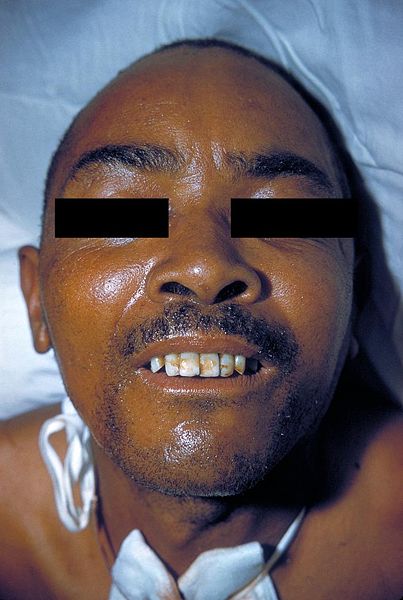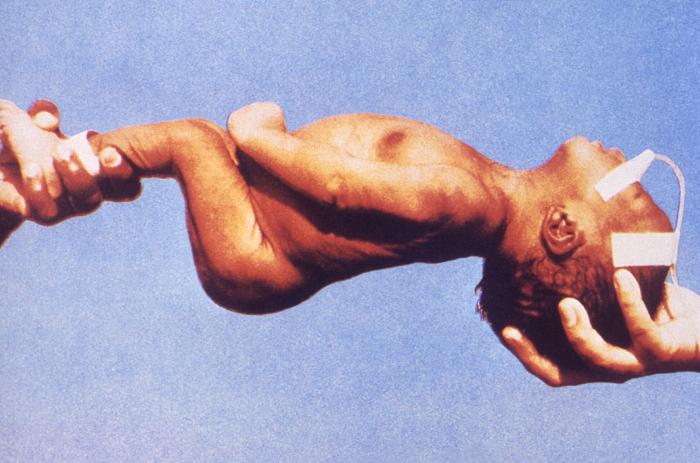Tetanus physical examination: Difference between revisions
Ochuko Ajari (talk | contribs) No edit summary |
|||
| Line 66: | Line 66: | ||
==References== | ==References== | ||
{{Reflist|2}} | {{Reflist|2}} | ||
[[Category:Disease]] | [[Category:Disease]] | ||
[[Category:Bacterial diseases]] | [[Category:Bacterial diseases]] | ||
[[Category:Infectious disease]] | [[Category:Infectious disease]] | ||
[[Category:Primary care]] | |||
{{WH}} | {{WH}} | ||
{{WS}} | {{WS}} | ||
Revision as of 14:39, 27 March 2013
|
Tetanus Microchapters |
|
Diagnosis |
|---|
|
Treatment |
|
Case Studies |
|
Tetanus physical examination On the Web |
|
American Roentgen Ray Society Images of Tetanus physical examination |
|
Risk calculators and risk factors for Tetanus physical examination |
Editor-In-Chief: C. Michael Gibson, M.S., M.D. [1] Michael Maddaleni, B.S.
Overview
The diagnosis of tetanus is completed through a physical examination. Tetanus infection produces some very clear symptoms that will be used for a clinical diagnosis.
Physical Examination
Some of the first signs a patient may present with are muscle stiffness, especially in the jaw, and headaches. From there, the patient may complain of symptoms such as neck stiffness, sweating, spasms, trouble swallowing, and the abdominal muscles becoming rigid. The following may also result:
- Many times the patients will be afebrile
- Late stage disease will show complications of autonomic dysfunction. An example of this would be periods of hypotension and bradycardia alternating with periods of tachycardia and hypertension.
- Patients with severe tetanus can present with:
- Opisthotonos
- Extension of the legs, flexion of the arms
- Spasms of the intercostal muscles and diaphragm will cause periods of apnea
- A rigid abdominal wall will most likely be present as well
The physical examination can reveal a few different forms of the infection. These include:
- Local Tetanus
- Uncommon form of the disease
- In the same anatomic area of the injury, there will be persistent contraction of the muscles
- Contractions may last for weeks before subsiding gradually
- It may precede generalized tetanus, but it is usually milder
- Approximately 1% of the cases are fatal.
- Cephalic Tetanus
- Rare form
- May occur with ear infections
- May occur following head injury
- There is involvement of cranial nerves, especially the ones in the facial area
- Generalized Tetanus
- Approximately 80% of reported cases.
- Presents with a descending pattern
- First sign is trismus
- Followed by stiffness of the neck
- Difficulty in swallowing
- Rigidity of abdominal muscles
- Other symptoms include
- Elevated temperature
- Sweating
- Elevated blood pressure
- Episodic rapid heart rate
- Spasms may occur frequently and last for several minutes
- Spasms continue for 3-4 weeks
- Complete recovery may take months
- Neonatal Tetanus
- Occurs in infants without protective passive immunity because the mother is not immune
- Usually occurs through infection of the unhealed umbilical stump
- This especially occurs when the stump is not cut with a sterile instrument
- More common in developing countries (estimated to be around 257,000 annual deaths worldwide in 2000-2003)
- Very rare in the USA
The Spatula Test
The "spatula test" is a clinical test for tetanus that involves touching the posterior pharyngeal wall with a sterile, soft-tipped instrument, and observing the effect. A positive test result is the contraction of the jaw (biting down on the "spatula"), and a negative test result would normally be a gag reflex attempting to expel the foreign object.

